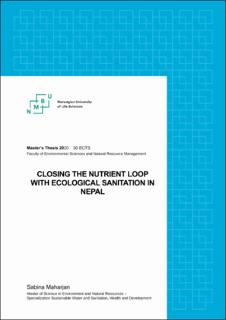| dc.description.abstract | Unsafe sanitation is one of the world’s largest health and environmental problems. Many countries face great challenges to provide adequate sanitation while leaving their people at risk of water, sanitation, and health (WASH) related diseases as diarrhoea which is the second -most leading cause of death in many countries. Although over 2.2 billion people gained access to improved toilets since 1990, sanitation was one of the most off-track Millennium Development Goals (MDGs) globally. The world missed the MDG target for sanitation by 700 million people with 2.4 billion still lack improved sanitation facilities and 946 million practicing open defecation. Now, the United Nations’ Sustainable Development Goals (SDG) states that everyone should have “adequate and equitable” sanitation by 2030. Nepal has been making considerable progress in expanding access to water and sanitation over the last few decades and despite the tremendous challenges such as poverty, difficult terrains, and conflicts, Nepal has formulated and enforced several WASH policies, guidelines, and acts. However, 10.8 million of about 29 million people in Nepal do not have access to improved sanitation. This study showed that ecological sanitation systems are promising for developing countries like Nepal because ecological sanitation is a circular economy, a “waste to resource” concept, and a closed nutrient loop sanitation system. In Nepal, the ecosan latrine concept was first introduced by ENPHO in 2002/2003 under the support of WaterAid Nepal with the implementation of Double Vault urine-diverting dry toilets. During the last few years, there has been rapid progress in the promotion of Ecosan toilets. By 2010, more than 770 Ecosan toilets had already been constructed (Messmer, 2011) and there is a demand for 3000 urine-diverting pans (Shakya, 2015). The nutrients contained in the excreta are recycled by using them in agriculture. Urine contains N, P, and K necessary for the plant growth in water-soluble ionic form and is therefore readily available for plant uptake. Human faeces also contain these elements though in lower concentrations along with organic matter essential for agricultural productivity. Not only nutrients but energy can also be recovered from human excreta by biogas production. Biogas is waste-to-energy technology that uses organic waste such as cattle manure, food waste, agricultural waste, and human excreta, separated or combined. The anaerobic digestion yielding biogas can also contribute to the necessary hygienization of the excreta. Source separated urine has been found to be a safe and efficient fertilizer for many crops and vegetables and has been studied in many different contexts since the late 1990s. However, human faeces are responsible for most diseases spread by human excreta as one gram of faeces contain about 100 million bacteria some of which are pathogenic. Therefore, faeces need to be hygienized either by dehydration or the composting process before its application. The slurry as a by-product of the anaerobic digestion process can be produced locally and used to increase soil fertility. However, findings showed that the biogas plant owners pay more attention to gas production and neglect the slurry application aspect. A developing country like Nepal needs a system that aims to treat the sludge generated from the septic tanks and reuse the end products such as biogas, treated sludge, compost manure, and water obtained after the treatment process. Despite the benefits, the application of human excreta in agriculture has been associated with health and environmental risks and socio-cultural issues. People need to transform the misconception of excreta as waste and dirt to view it as a resource and treat the excreta properly to produce a safe fertilizer product supplemented by biogas generation. | en_US |

